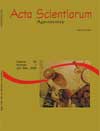<b>Desempenho agronômico da soja sob diferentes rotações e sucessões de culturas em sistema plantio direto</b> - DOI: 10.4025/actasciagron.v31i1.6631
Resumo
Este trabalho faz parte de um projeto de longa duração que teve início em 1997 e envolve produção de grãos baseada em sistemas de rotação ou sucessão de culturas. O experimento foi desenvolvido no ano agrícola 2005/06, em LATOSSOLO VERMELHO Distroférrico, na Fazenda Experimental de Ciências Agrárias da Universidade Federal da Grande Dourados - UFGD, em Dourados, Estado de Mato Grosso do Sul. O delineamento experimental foi em blocos casualizados com sete tratamentos e três repetições. Em cada parcela, foram semeadas mecanicamente 26 linhas de soja com 36 m de comprimento, espaçadas entre si por 0,45 m. Os tratamentos consistiram de sete sistemas de rotação ou sucessão, envolvendo espécies semeadas solteiras ou com misturas de espécies antecessoras a soja, constituindo os seguintes tratamentos: Sistema 1: crotalária+ervilhaca/soja; Sistema 2: ervilhaca+aveia+nabo/soja; Sistema 3: girassol/soja; Sistema 4: milheto/soja; Sistema 5: milho/soja; Sistema 6: trigo/soja e Sistema 7: aveia/soja. Foram avaliadas a altura de planta, altura de inserção da primeira vagem, número de ramificações por planta, número de vagens por planta, produtividade da soja, massa de 100 grãos. Concluiu-se que podem ser utilizadas várias espécies em rotação ou sucessão de cultura com a soja no sistema plantio direto consolidado, sem afetar os componentes de produção da leguminosa.Downloads
DECLARAÇÃO DE ORIGINALIDADE E DIREITOS AUTORAIS
Declaro que o presente artigo é original, não tendo sido submetido à publicação em qualquer outro periódico nacional ou internacional, quer seja em parte ou em sua totalidade.
Os direitos autorais pertencem exclusivamente aos autores. Os direitos de licenciamento utilizados pelo periódico é a licença Creative Commons Attribution 4.0 (CC BY 4.0): são permitidos o compartilhamento (cópia e distribuição do material em qualqer meio ou formato) e adaptação (remix, transformação e criação de material a partir do conteúdo assim licenciado para quaisquer fins, inclusive comerciais.
Recomenda-se a leitura desse link para maiores informações sobre o tema: fornecimento de créditos e referências de forma correta, entre outros detalhes cruciais para uso adequado do material licenciado.




















































